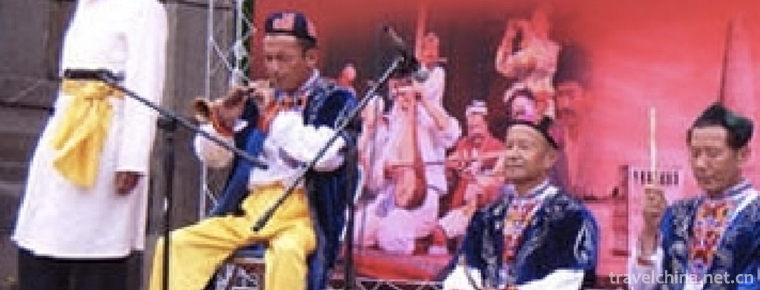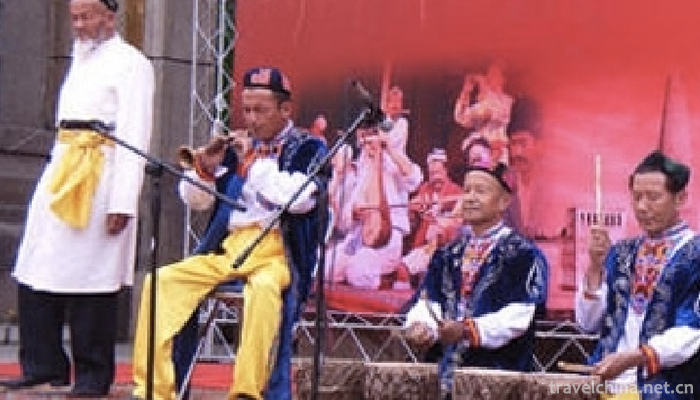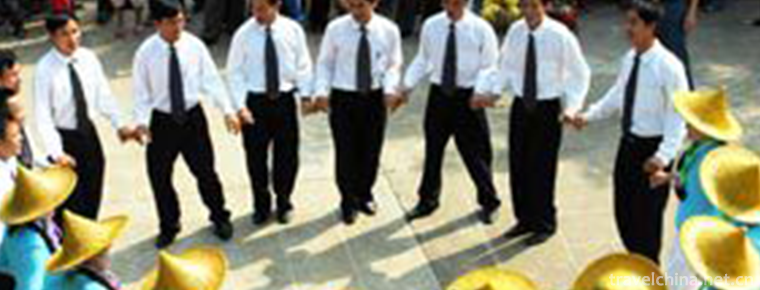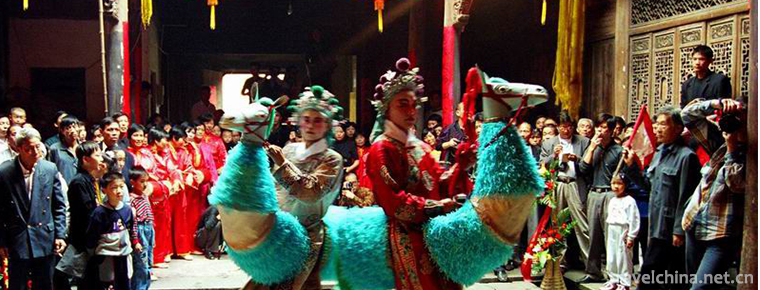2019-04-25

- By ChinaWiki.net
- Chinese Edition
- 2019-06-26
Uygur Drum Music
Uygur drumming music is a kind of national instrumental music widely circulated in the Uygur communities in the north and south of Tianshan Mountains, Xinjiang. Uygur drum music is an important kind of Uygur instrumental music, widely distributed in Xinjiang Uygur communities. Uygur drumming music mostly plays a sonai melody, three pairs of Nagra and a winter buck festival. It can play pieces of Uygur Mukam and spread music of Uygur songs and dances all over the country, as well as relatively fixed advocacy Suites (such as "Twelve Ili Uygur advocacy suites") which are spread in different regions.
The main function of Uygur advocacy music is to accompany mass self-entertainment dance, which is indispensable in all Uygur festivals and rituals of life. Uygur drumming music circulated in different areas has different band composition, music style and other aspects, but its melody is fluent and fluctuating, rhythm, rhythm is complex and changeable, can create a warm and happy atmosphere. Turpan is more famous for playing the melodies of Turpan Mukam from beginning to end in the form of advocacy music.
On June 7, 2008, Uygur drumming music was approved by the State Council and listed in the second batch of national intangible cultural heritage list.
historical origin
The ancestor of Nagra Drum was introduced into the mainland through the Western Regions in the Southern and Southern Dynasties, and it prevailed in the Tang Dynasty. Nagra's production materials have gone through the process from ancient wooden drums and bangs to iron resonators, and the way of playing has evolved from "two-sided collision" to "one-sided collision". Surnay is a wind instrument in drum music. It originated from Arabia at first and then spread to the Western Regions. On the basis of inheriting the original music culture, the Uygur people who moved west to Yili have created twelve sets of drumming music with rich contents and complete forms, and made them have distinct national characteristics after more than 600 years.
artistic characteristics
Self-entertaining solo instrument is the most popular form. It covers farmers, small handicraftsmen, other workers, and all levels of urban and rural areas, such as herdsmen grazing livestock on the grassland; camels and camels trudge along the Hanhai Gobi, often playing melodious music such as Pabiqi and Kaerwan. Farmers in the shade of trees and orchards after work, using Baraman to play some folk tunes or using Rewafu to play some dance songs, folk song suites, etc., to relieve the fatigue of labor. In our daily life, we usually use the soft voice of Dutar, Bull, play some music, dance music, or sing some beautiful folk songs by ourselves to express our feelings.
Su Nai is made from thorny wood or paulownia wood to form straight pipes with thin upper and thick lower ends and more bell mouths, and copper bowl mouths at lower ends. The tube is decorated with bone patterns and coloured gems. Seven to nine sound holes are opened or one snow is added to the left side. Reed whistles are inserted on the tube. The length of the tube is not uniform but the shape is roughly the same. Both Nagra and Dongbach played with wooden sticks and can-shaped single-sided drums. Their chambers were made of pig iron or hollowed out from the trunk of Populus euphratica, covered with sheepskin. Three pairs of Nagra are called head drums, middle drums and tail drums according to their size and pitch. Head drums often make complex variations and play a leading role in the whole orchestra; middle drums take turns with head drums while playing the basic rhythm; tail drums are generally large in shape and low in pronunciation, mainly playing the basic rhythm type. Winterbuck only hits bass in various rhythmic positions.
Uygur advocacy music is often used in festivals, weddings and other festive occasions, but also common in the folk often held a variety of rituals of Maxie Refu and worship of Saint Mazar. Because of its distinct rhythm, high voice, agitation, good at rendering the festive atmosphere, and often as the accompaniment of the mass square dance and folk acrobatics "Dawazi" performance; according to legend, in ancient times it was also used as a military music to inspire morale.
Uygur drumming music, besides playing some sporadic music cards, is also a trend towards divertimentation. There are different "advocacy music divertimentos" in northern and southern Xinjiang, among which the famous ones are Ili Twelve Drum Music Sets, Yer and Miles in Turpan, Sainem in Korla, Samar Dance in Kashgar and Shetiana. Its structure generally starts with the prelude of Sanbang, followed by a series of slow and fast, from lyric to happy and warm music, and finally ends with Sanbang phrases.
Representative Works
Representational repertoires include "Ili Sainem", "Kurkeim", "Xie Diyang", "Xiehai Er Ma Li Mu", "Ilanda Sainem", "Turpan Nawamukam".
Inheritance Significance
In the process of global economic integration, the social role of culture is becoming more and more important. Successful application of intangible cultural heritage has added a strong cultural brand to Ili. But this is only the first step in the long march. Only by protecting them can we truly enhance the cultural charm of Ili and build a splendid and moist spiritual home.

Ask a Question
Your email address will not be published.



0 Questions